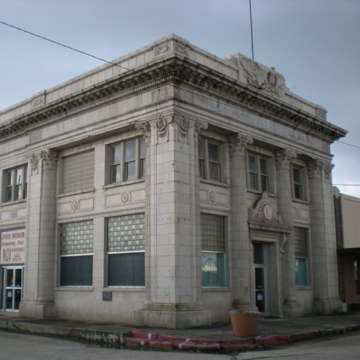Typically in the early twentieth century, each small town in the Delta had one bank to indicate the community’s financial strength. The bank buildings invariably were classical in style, two stories in height, and with a stone or glazed terra-cotta facade. Today, many of the once-flourishing downtowns have decayed around these banks, and they are often left standing alone, such as has happened here. This elaborately adorned building, which occupies a corner location opposite the Missouri Pacific Railroad depot, was built with its narrow, principal facade on Front Street and its long side on Walnut Street. The facade is clad in glazed terra-cotta and boldly articulated with engaged Composite columns and a heavy entablature with dentils and brackets. A basrelief eagle with outspread wings decorates the parapet. The central entrance is decorated with moldings, dentils, and a cartouche framed by a double cornucopia. On the first floor were banking areas, offices, and a staircase leading to a large hallway on the second floor and more offices. It was in one of these upstairs offices that in 1924 Wesley Bengel formed the Jackson County Farm Credit Association, the first farm credit association in Arkansas and the second of its kind in the United States. Bengel made loans available to local farmers. In 1930 the Arkansas Bank and Trust Company went into receivership, and years later the building was purchased by First National Bank, which remained at this location until 1967. Since that time the building has held commercial enterprises and offices. Architecturally, some windows on the long side have been infilled, and others have been changed to glass block.
Opposite the bank is the former Missouri Pacific Railroad Depot (1904), a long brick building covered in stucco, with a hipped roof and deep eaves supported on brackets. The station served both passengers and freight, and its large size illustrates the important role the railroad made to the town’s economy.


